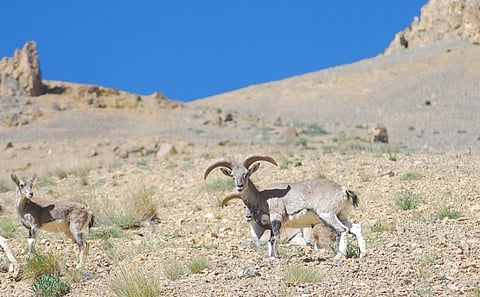

Wildlife authorities in Himachal Pradesh’s high altitude, cold desert district of Lahaul & Spiti have started surveys as part of census to estimate the population of blue sheep or bharal and the Himalayan ibex, the main prey of the iconic snow leopard.
Field staff from the National Conservation Foundation and Wildlife Division, Spiti, will survey the challenging terrain of the district which borders Chinese-controlled Tibet for the next 15 days.
“The surveying is being done through the double observer survey technique,” Deputy Conservator of Forest (Wildlife) Spiti, Mandar Jeware, told Down to Earth (DTE).
A total of 453 blue sheep were spotted in the district’s Tabo area on the first day of the survey, Jeware noted. He added that there is a complete ban on hunting of all types of wild animals including blue sheep and Himalayan ibex in Lahaul & Spiti.
Most people in the district are Buddhists and are not involved in hunting-related activities. No case of poaching has been reported in this area yet.
The numbers of blue sheep and Himalayan ibex have been increasing in Lahaul & Spiti in recent times due to the collective efforts of the forest department and locals.
Field staff surveying the landscape for blue sheep and Himalayan ibex. Photo provided by Rohit Prashar
Lara Tshering, a youth from Langcha village who is involved in the wildlife conservation and tourism business, told DTE that the two animals are now commonly seen roaming in his village. This has consequently led to increasing snow leopard sightings too.
Snow leopards, the apex predator of High Mountain Asia, are classified as ‘vulnerable’ under the International Union for Conservation of Nature’s Red List of endangered species.
Tshering added that locals, in keeping with their Buddhist beliefs, have taken a pledge not to hunt wildlife. If any wild animal is found injured due to some reason, it is handed over for treatment to the forest department.
The increase in snow leopard, blue sheep and Himalayan ibex sightings has also led to an increase in wildlife tourism activities in the region.
With many locals catering to the thousands of tourists who visit the cold desert every year to see these animals, they consequently do not want to harm but conserve them instead.